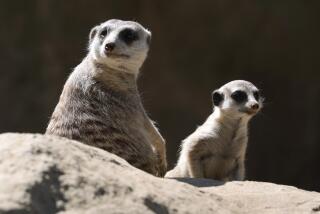Elephants unpack their trunks
- Share via
Madeleine Kaufman got up at 4:30 a.m. Thursday, she was so eager to visit the elephants in their new exhibit at the Los Angeles Zoo. Seven hours later she was standing at a railing studying the behavior of the zoo’s two female Asian elephants. Jewel was using her trunk to sprinkle her backside with hay. Tina wasn’t.
Madeleine pointed at Tina. “She’s not dirty yet,” the 2 ½-year-old observed in a voice that might have signaled approval or maybe disappointment.
Jewel, oblivious, threw more hay on her head.
After years of controversy and more than a decade in the works, the L.A. Zoo’s $42-million “Elephants of Asia” exhibit opened to the public Thursday. People and pachyderms — Billy, Tina and Jewel — finally got a chance to glimpse one another across the elaborate enclosure, the zoo’s largest.
Instead of the old exhibit’s half acre of dirt and concrete, the new enclosure offers 3.8 acres — sand, grassy hills, swimming pools, a waterfall. There’s also a two-story barn with radiant-heated floors.
The public walkways wind through sections named for Asian countries — Cambodia, Thailand, China and India — with video presentations on conservation and fundraising efforts. A maze of flexible fencing allows zookeepers to cordon off one elephant or open gates and let one or more of them roam.
“For photography, it stinks: too many poles in the way,” said Bernice Cauthey, training a mega-zoom lens on the zoo’s 25-year-old Asian bull, Billy, who was standing on a grassy slope. “But it’s big. The elephants should really like it.”
Cauthey had brought her sister, her brother and her 103-year-old mother to opening day. All have been to India, where they saw elephants. “We come to the zoo quite often and we’ve been watching this develop for — what? Two years?”
More. Over the last five years alone, the zoo’s elephant exhibit has been scrutinized by the City Council and the mayor’s office, opposed by animal welfare advocates — who argued that it would never be big enough for the world’s largest land mammal — and doggedly championed by zookeepers and officials who insisted that the exhibit would both meet the pachyderms’ needs and provide crucial education about conservation efforts in the wild.
On Thursday, several longtime animal-welfare advocates showed up to get a firsthand look.
They watched as Billy stood bobbing his head — behavior that welfare advocates say is a sign of zoo-induced stress.
Catherine Doyle, elephant campaign director for In Defense of Animals, praised some of the exhibit’s features. “I’m so happy to see Billy with a water feature,” said Doyle. “I’m pleased he has to walk up hills — that the exhibit is not all flat.”
She wasn’t happy about the fencing, though. “I see a lot of fragmented spaces. The zoo boasted about all this space, but it seems a shame they don’t have access to it all.”
But Jennie Becker, the zoo’s curator of mammals, said the fencing gateways allow numerous ways to open the space for the elephants. “There’s a lot we can do,” said Becker, noting that Billy’s enclosure is so extensive that from the area near the Cambodia pavilion “he can walk all the way to India.” (She meant the so-named sector of the elephant exhibit.)
As for the fence poles that were marring Cauthey’s photos, Becker noted that various vantage points offer different views. Near his waterfall and pool, Billy is dramatically close to visitors.
Becker said the zoo’s latest additions, Tina and Jewel — who arrived from the San Diego Zoo last month — “seem really relaxed.... Tina and Jewel are so vocal, they talk to each other.” Long bonded with each other, they are now curious about Billy. “They vocalize whenever they’re near him.”
Tina is between 37 and 44 years old, Jewel between 42 and 47. Though beyond their mating years, they’re on birth control, Becker said.
The females are kept together — and separate from Billy. But that may change, which might make Billy happy.
“He’s very interested in the girls,” said Becker.
More to Read
Sign up for Essential California
The most important California stories and recommendations in your inbox every morning.
You may occasionally receive promotional content from the Los Angeles Times.











